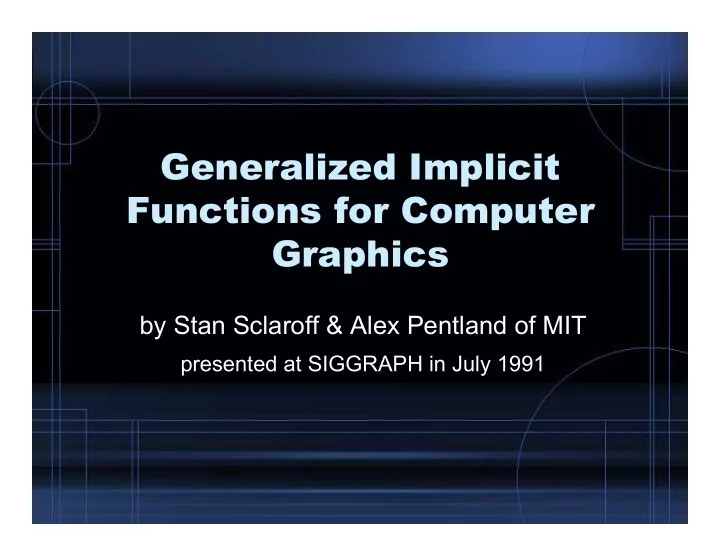

Generalized Implicit Functions for Computer Graphics by Stan Sclaroff & Alex Pentland of MIT presented at SIGGRAPH in July 1991
The Problem
The problem is common • Detection and characterization of collisions is a common problem in both graphics and simulation • Standard representations of polygons/ splines/curves are not suited for collision detection
The problem is also complex & costly • the complexity of the problem is O(nm) (n = number of polygons, m = points to be considered after pruning) • collision detection is one of the most costly problems in graphics applications (particularly games)
The (Proposed) Solution
Implicit function representation (spheres, superquadrics) • O(m) complexity • allows for better characterization of surfaces, leading to improved simulation of multibody collision
What needs to be done • Generalize implicit functions for general shapes • Fit these functions to three-dimensional points
What are generalized implicit functions? • Defines a function as a level set of a function f(x), usually f(x) = 0
Example • (x^2)+(y^2)+(z^2)-(r^2) = 0 (a sphere) • The above function defines the boundary of a sphere • Can also apply rotation, translation operators
Example function (x^2)+(y^2)+(z^2)-(r^2) = 0 • To detect a collision between a point and the surface, substitute X=(x,y,z) into the function – If negative, point is inside the surface and collision has occured
So how do we generalize this further? – Apply deformation matrix D to point x (on top of rotations, translations) – D should be invertible – D is based on parameters u, which are the parameters of various free vibration modes – Leave center of mass and vibration fixed
How do we generalize this yet further? • Set f(x) = d, where d is a "displacement function“ – displacement function is based on n, omega, the point's coordinates on the surface's parametric space – This displaces the surface along the surface normal before applying the deformation matrix
Example from ThingWorld Figure 1: Two frames from a physically-based animation in which seashell like shapes drop through water and come to rest.
3D Data Fitting • Using point data, create a generalized implicit function • Need to find mapping between X and X~, points before/after deformation and displacement • Can compute Jacobian of D using finite differences, and then estimate (Newton's method) to find u parameters • Use residual differences to compute displacement map d • Solve for the displacement map value using least-squares analysis
Example from ThingWorld Figure 2: Two frames from a physically-based animation in which a head deforms in response to getting bonked.
Results • These methods help make real-time, non-rigid simulations possible • Reduces cost of contact detection, physical simulation • Can easily convert raw data to an implicit function for simulation purposes.
Recommend
More recommend